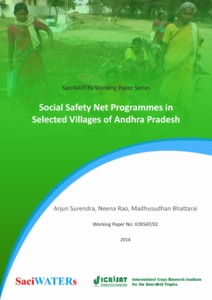Social Safety Net Programmes in Selected Villages of Andhra Pradesh. SaciWATER Working Paper 02/2014
Abstract
Social Protection Programmes are those programmes instituted by governments or society that help protect citizens from “risks, vulnerabilities and deprivations”. Social Protection can be considered like an insurance against poverty, this can be instituted by governments (official social protection) or otherwise (unofficial social protection). Social Safety Nets are subsets of such programmes Such protection is needed as poverty is a major issue in rural India, 72 percent of the population lives in rural areas. It is estimated that 42 percent of the rural population lives below the poverty line. This is especially true in the semi-arid tropics of India, where 40.5% of India’s rural poor lives, despite only covering 37% of the country’s area. The rural poor in SAT India are faced with the shocks and seasonalities that increase vulnerability, such as the issues of water scarcity under increasingly variable climatic conditions, food security and issues of livelihood security. SAT Andhra Pradesh is no different. This paper examines the issues that had an influence on vulnerability in four selected villages in Andhra Pradesh in India and examines how, if at all, social safety net programmes alleviate these issues. To this end focus group discussions and informal interviews were carried out among landless and landowning inhabitants of the village. The findings of the study are as follows. Though issues differ slightly from village to village, a common thread was seen in the form of lack of access to water resources for farming which has far reaching impacts, on migration, labour availability and even food security. Additional issues reported were of sanitation and fluctuating prices, both in terms of selling agricultural produce, as well as purchasing essential commodities. A large number of safety nets function in these villages, among these, the major programmes include the Mahatma Gandhi National Rural Employment Guarantee Scheme, Public Distribution Systems, Self Help Groups, health insurance schemes, housing schemes, agricultural subsidies, loan waivers and so on. It was found that though official social safety nets were functional in all villages to varying degrees, their reception and impacts have been mixed. Of the official formal safety net programmes, only self help groups were reported as functioning excellently, and not many complaints were raised about it. With respect to the other official safety nets, there were gaps identified in the implementation on the ground, mostly due to lack of monitoring. Thus there is room for improvement in this regard. Respondents state that even when fully functional, these programmes often do not help them with the problems faced in the village. People often resort to unofficial safety nets, due to urgent need, or even due to official safety nets not being effective in that case. Among the unofficial safety nets, it was found that borrowing from friends and relatives is the most common and preferred method of obtaining money in times of need, as is credit at local village stores. Thus, it was seen that the social safety net programmes do not fully address the issues that are faced in the village, in order to get better results, it is important to increase transparency in the implementation process, additionally, even though there is existing convergence between government schemes, more convergence and streamlining would be beneficial. Another issue is the lack of ownership among the beneficiaries, where community led initiatives to solve problems are lacking. This could be addressed through advocacy and capacity building, through a rights based approach

